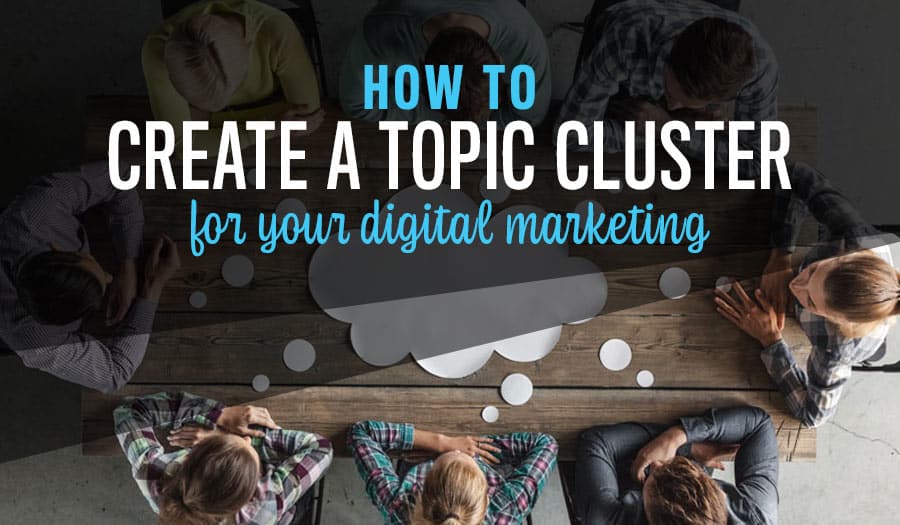For the uninitiated, a topic cluster may sound like something you need a prescription from your doctor to address. Still, topic clusters are the foundations of future success in SEO and content strategy for those in the know. Let’s explore How to Create a Topic Cluster for Your Website.
Topic clusters will help you leverage your brand when used effectively. They will benefit your website in many ways, such as:
- Boost your traffic
- Higher organic rankings and greater conversions
- Improved results around every item of published content on a given topic, and
- Increased authority with your audience.
Regarding your content strategy and SEO, the effort to create topic clusters is well worth the reward. You are probably wondering where to begin when it comes to building out topic clusters for your business website. Don’t worry, by simply following our tips below, you can build topic clusters yourself with just a little planning:
How to Create a Topic Cluster
1. Getting started
Identify your main topics. Your topics should align with what your business sells or does. Ask yourself:
- What is relevant to your audience and your brand?
- What are the problems your audience faces?
- What topics would you like your business to be the known authority on?
- Why do people use your products or services – what do they hope to accomplish?
You should already have a handful of ideas!
2. Brainstorm
Brainstorm each main topic with your team. Think about the sub-topics (or just about areas that relate to these main topics). Don’t worry about whether an idea is good or so-so. Write it down! Next, rank these ideas from ‘awesome’ to ‘just okay’, and delete the duds.
You may have an overlap between topics, and that’s fine. It will help you to boost your rankings in search engines in the long run. Narrow down your ideas to a ‘Best-5’ for each main topic. These are your sub-topics. Keep a file of all the ideas you didn’t use to revisit at a later date. Their relevance could increase -or you may never use them – but they are a great way to kick-start your next brainstorming session.
3. Keyword research
Keyword research is fundamental: for a compelling topic cluster theme, you need to know what your prospective customers are searching the web for.
This is also a great way to uncover additional ideas for content to add to your relevant topic clusters. As you begin to build out topic clusters, you aim to create multiple pieces of content that revolve around one central topic, each with different keyword phrases.
4. Plan topic-based content
Ideally, you should create your own 3-6 month content plan as a minimum. If you manage to brainstorm enough content ideas, you could even aim for a 6-12 month content plan.
Map out each of your planned main topic pillar pages first, and then list your sub-topic ideas underneath each one. By writing it out, you will see how each piece of content can be organically linked together and, hopefully, you will be able to decide the logical order in which the content should be published.
Next, select your core keyword topic for each pillar page. Then, select numerous related keywords related to your sub-topic pieces of supporting content. You are now ready to begin producing your content.
The content you produce could be website pages, blog posts, videos, social campaigns (including social media ads and PPC) or microsites. You can raise awareness of your content by including email in your promotion plan. With a 4000% ROI, adding email promotion to the list makes perfect sense.
5. Lock it into your calendar
Set realistic deadlines when deciding how long it will take you to create each piece of content. Then, schedule each piece on a marketing calendar. As you plan each piece of content on your calendar, set reminders for each of these deadlines. If delegating various tasks, ensure each team member owns their responsibility to provide their area of content (video, images, text) by the deadline date. The added work will pay off in growing your business – don’t let your momentum slide by making sure to stick with your marketing plan!
6. Content structure
For topic clusters to be effective, your content must be internally linked.
When your content is created (main topic pillar page and sub-topic pieces of content), sit back and look at the main topic of your topic cluster as your main “idea” and assess each of the many pieces of sub-content created to sit around it, making sure it all links together organically. It truly isn’t as hard as it sounds!
Interlinking your content is vital, so take time to consider how each sub-topic will revolve around the main topic of your topic cluster and where and how the content will be interlinked. These links should be natural, based on the content itself. Ideally, the main topic should have both outbound and inbound links to the supporting sub-topic content.
7. Establish authority around key topics
Your content strategy must work methodically towards this aim to position your business or brand as an authority on a given subject. Be deliberate about creating numerous pieces of high-quality content around the topic you want to establish yourself as the authority on. With multiple pieces of content focused on various aspects of the same topic, you will present yourself as a reliable, authoritative resource – leading to an increase in traffic, rankings and conversions.
8. Review and update
Continual iterations to your web content ensure search engines notice, so make sure you review and update your content to keep it relevant and up to date.
Shifting your inbounding marketing strategy focus from keywords to topic areas is daunting. It is also an undertaking that will be exceptionally advantageous to your business over time. In doing so, you will make it easier for potential customers to find your website and instead of heading back to Google to search for more answers, your links will keep your visitors on your site as they find the answers to their questions are all there.
You need a solid content strategy if you are chasing that lucrative No.1 position in search engine results pages. It takes work (and it means sticking with your 3-6 or 6-12 month plan), but if you are serious about growing your business, it will prove very worthwhile.
If you’re looking for help building a content plan for your business that will secure the results you need, why not contact us for a chat? We’re here to help answer any of your questions, from SEO and content strategy to any aspect of your website you’d like to discuss.
Let Sydney’s leading Web Design Agency take your business to the next level with a Pixel Fish Small Business Website.
Check out some of our latest Website Design projects and Testimonials.
Further Information
How to Create a Saleable Business Using Your Website
Top 5 Online Learning Platforms to Help You Grow as a Business Leader
10 Tips to Becoming a Thought Leader in Your Industry
Top 10 Ways to Use QR Codes to Promote Your Business and Your Website
Top Reasons Why Your Website Speed Impacts Your Business
Top 20 Website Accessibility Tips for Creating a W3C Website
How to Set Up Your Home Office for Video Meetings
Top 5 Web Browsers for WordPress Website Editing
Website Platform Review: Squarespace vs WordPress



